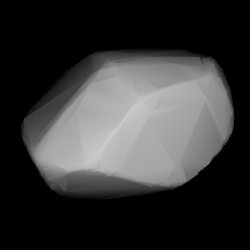 Shape model of Korolev from its lightcurve | |
| Discovery [1] | |
|---|---|
| Discovered by | L. Chernykh |
| Discovery site | Crimean Astrophysical Obs. |
| Discovery date | 8 October 1969 |
| Designations | |
| (1855) Korolev | |
Named after | Sergey Korolyov (Soviet rocket engineer) [2] |
| 1969 TU1 ·1961 JD 1964 DD | |
| main-belt · Flora [3] | |
| Orbital characteristics [1] | |
| Epoch 4 September 2017 (JD 2458000.5) | |
| Uncertainty parameter 0 | |
| Observation arc | 55.74 yr (20,358 days) |
| Aphelion | 2.4363 AU |
| Perihelion | 2.0583 AU |
| 2.2473 AU | |
| Eccentricity | 0.0841 |
| 3.37 yr (1,231 days) | |
| 286.81° | |
| 0° 17m 33.36s / day | |
| Inclination | 3.0793° |
| 191.03° | |
| 349.40° | |
| Physical characteristics | |
| Dimensions | 6.789±0.253 km [4] 7.47 km (calculated) [3] |
| 4.65±0.01 h [5] 4.656199±0.000001 h [6] 4.6568±0.0001 h [a] 4.66±0.01 h [7] | |
| 0.24 (assumed) [3] 0.319±0.032 [4] | |
| S [3] | |
| 12.70 [4] ·12.8 [1] [3] | |
1855 Korolev (prov. designation: 1969 TU1) is a stony Flora asteroid from the inner regions of the asteroid belt, approximately 7 kilometers in diameter. Discovered in 1969, it was later named after Soviet rocket engineer Sergei Korolev. [2]